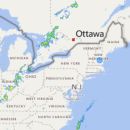
New England Weather Is Unpredictable: Ensuring Your Home or Business Is Storm-Ready Shouldn't Be
Living in New England, residents are accustomed to the fluctuating temperatures and ever-erratic weather patterns that can bring pop-up storms and unexpected rain showers. Here in the Granite State, snowstorms, wind-driven rain and heat waves are ordinary occurrences, and can sometimes be experienced in the same week! While most New Hampshire (NH) residents are accustomed to the unpredictable New England weather, many home and business owners may not be aware of the steps needed to ensure their home or business is “storm-ready.” Sure, those pop-up summer rain showers may be quick and uneventful, but torrential downpours and wind-driven rain can lead to interior flooding, roof damage and clogged gutters.
Types of Storm Damage
In NH, residents can experience a multitude of weather patterns, ranging from snow and ice storms to high winds and the occasional tropical storm. With weather in the Granite State being as unpredictable as your mother in-law’s opinion of the holiday dinner, what types of damage should home and business owners be aware of? The most common types of storm damage that residents can experience are:
- Roof leak or stripped shingles
- Clogged or damaged gutters
- Interior flooding (typically seen in low-lying areas such as the garage or basement)
- Leaking windows
- Burst pipe(s)
- Fire damage from a lightning strike
- Appliance failure after a power surge
Preparing for a Storm
According to the National Oceanic and Atmospheric Administration (NOAA), in 2015, there was over $250 million dollars’ worth of property damage from thunderstorm winds alone. Whether a storm is predicted in the upcoming forecast or strikes unknowingly, there are a few steps NH residents can take to ensure their home or business is “storm-ready.” It’s time to make you’re your property doesn’t contribute to the next storm damage statistic. A few steps every home and business owner can take to prepare for a storm are:
- Ensure all gutters and downspouts are free of debris.
- Trim or remove tree branches near the structure to reduce the risk of property damage.
- Check the caulking around all windows and doors to confirm they are fully sealed.
- Remove or secure any lawn items that can easily blow into or damage the structure.
- Store items that are in low-lying areas in safe places that will not get damaged if a flood
- Have a professional assess the roof for any damage or to provide maintenance prior to a storm striking.
- Have extra batteries, flashlights and bottled water in the event of a power outage.
Visit NOAA to learn more about various types of storms and storm damage.
Soil-Away Helps Disaster Cleanup After Storms
Soil-Away is a family-owned and operated business with over 25 years of storm damage restoration experience. Has your home sustained fire damage from a lightning strike? Do you have water pouring through your roof after a rain storm? The expert team at Soil-Away is here to help you recover from property disaster 24/7. Don’t hesitate to call 603-641-6555 if your property has fallen victim to storm damage.
Written by: K. Gnatowski

